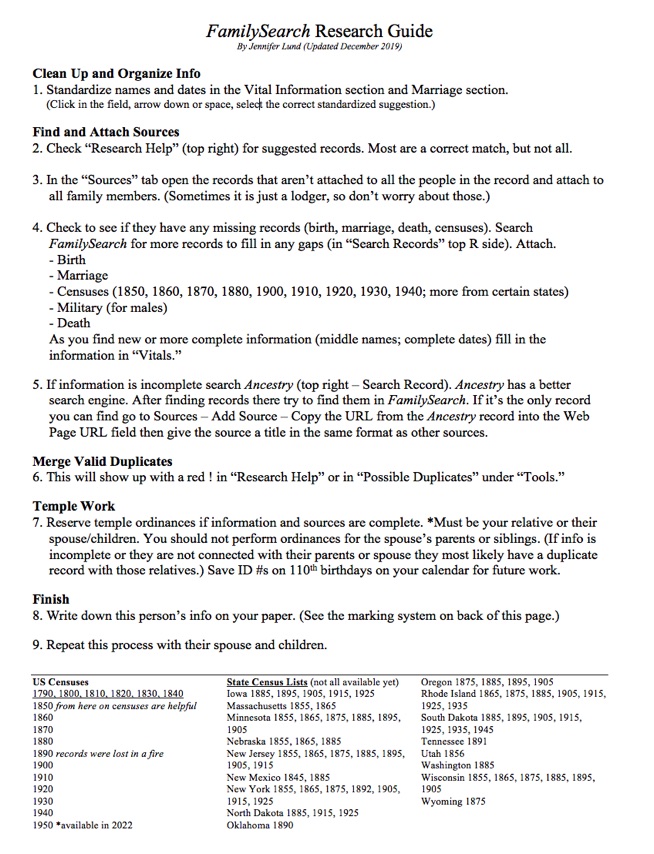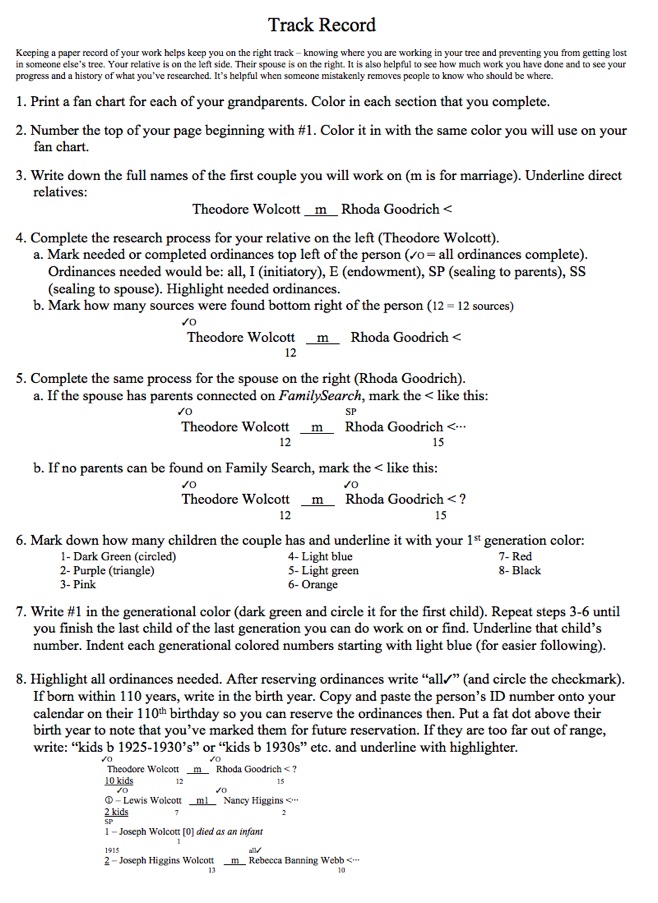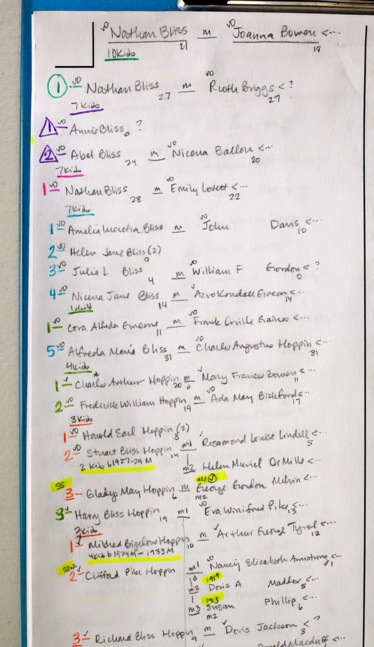Friday, January 11, 2019




My System for Family History Work
Here’s an overview of how I keep track of the family history work my kids and I are doing. *Updated Mar 2020.
Background: all of my grandparents and Jon’s descended from pioneers in The Church of Jesus Christ of Latter-day Saints except for both of our paternal grandmothers.
Even though both grandmothers are converts to The Church of Jesus Christ, all of their direct ancestors’ ordinances have been completed.
Because of this I focus on Descendancy Research: researching all of the descendants of one couple.
There are two parts to this: tracking and research.
Tools needed for tracking: Clipboard, white paper, colored pens, highlighter, pencil, ruler
I start by printing a fan chart with one of our grandparents as the center person. I then choose a couple to start researching. I only go back as far as there are good records. The first useful U.S. Census was taken in 1850, so as long as the couple or their children lived sometime during that census I will choose them.
Next, print this PDF (or get a piece of paper and draw a black line down the center). Label it with page #1 top right. Choose a color for this family line and fill in the number box.
Pencil in the first couple’s name at the top-left of the page and underline them. (Underlines mean they are a direct ancestor.) Color in the couple’s names on the fan chart to match the page number’s color. This makes it easy to remember which line we are working on.
Next, research the person on the left (Henry Shaw) with the system below. (Tidy their information, add all possible sources for them, correct and fill in all information completely, and take care of any duplicates.) Then research their spouse the same way.
When moving on to their children, a color-coded system begins: a color for each generation.

Tracking: Each generation of children gets their own color. This is super helpful so you don’t get lost or forget which generation you are on. (I originally started my system all in pencil and left out a ton of people because I accidentally skipped people or a generation. The colors solved that problem.)

I got a stand-up pencil holder for my writing tools. One child keeps hers in a small shallow box. Another keeps them in a small jam jar.
Here is one page of research as an example. It looks crazy at first, but it makes sense once you get going.
While there may be software options for keeping track of family history work I prefer a paper copy. I have so many windows open on my screen that I don’t want yet another one to manage.
When I finish a page I count the number of people I researched and total it at the bottom. The yellow highlights indicate ordinance work that needs to be done. I also count the number of people whose ordinances I reserved right away and also those I put on my 110-year calendar. Blue highlights show foreign countries a person or their parents are from.
When I finish the entire line of descendants I tally them and write that onto the fan chart. It is amazing how many descendants one couple can have! This ranges from hundreds to thousands. (My biggest line so far had 6,883 descendants.)
On each clipboard I have: their line of research, the instruction page and a colored fan chart. HERE is a PDF of the instruction pages.
This has been an excellent system for our family to keep track of where we are on our family tree. You can easily get lost, especially as you work on a spouse’s family in order to fully research the spouse. Having the paper tracking system there helps tremendously.
This also makes family history a bit addicting if you like complete collections! You want to keep going until every single family member has been researched. I have been amazed at how many family members need temple work. I may go a while without finding any and then BOOM! I find a pocket of people who need all of their ordinances.
My four oldest kids have their own family line to work on. I dabble in each one to help them and get them through any “boring” sections.


Here is my systematic way of researching each person:
*This is the key to finding people whose work needs to be done. In locating marriage records, birth and death records you find spouses and children, children left out of the system because they were only on one census before they died, or records have been recently indexed, etc.
Cleaning up all the information and organizing it so you can see which records are missing and then filling the gaps makes a person’s record complete and tidy, after which you can feel at peace that you’ve done all you can to find this person’s complete family. Also, after all the information is in standard formats and as complete as possible, the system is able to find and suggest possible record matches, which often find new family members to attach to the person.
It is also a way to make sure there are no duplicates. A FamilySearch source can only be added to one person, so attaching all possible FamilySearch documents helps the search engines find duplicates who may be attached to a document about this individual.
HERE is a PDF of these instruction pages.




Mark down how many kids the couple has. Underline that number in the first generation’s color (dark green). Research this first child/couple.
Then write down how many kids they have and underline it in the second generation’s color (purple). Complete this couple. Continue switching colors for each new generation of children. Underline the last child’s number, then continue the next number in the generation above....
There are more details on the sheets below, but there are numbers and symbols for each person to show at a glance their status. This is helpful when you return to a line later -- you can see who needs to be checked up on.
This is all part of tracking.



This is what my grandmother’s side looks like. When I finish each line, I put them in order behind the fan chart in their coordinating line colors left to right.

Then I file them with the fan chart in front and all the family lines stacked behind it.
It’s hard to demonstrate in writing and pictures how all of this is done, but I hope that sharing this helps you in your pursuit of family history research.
